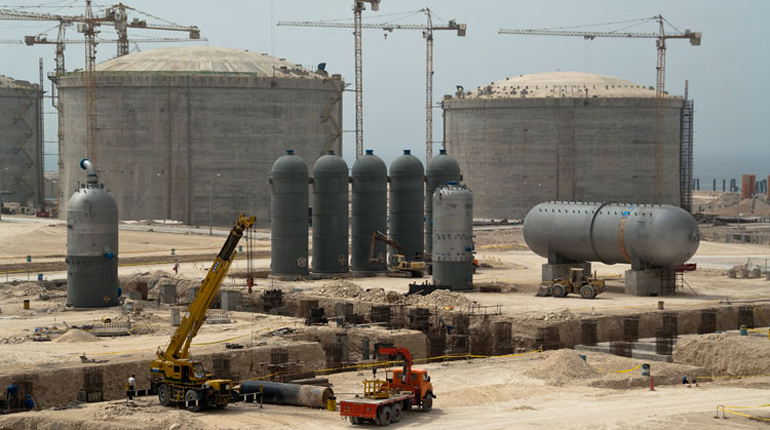 Iran LNG under construction. The project will cost up to $6-7 billion to complete. (Iran LNG Co.)
Iran LNG under construction. The project will cost up to $6-7 billion to complete. (Iran LNG Co.)
National Iranian Gas Export Co. (NIGEC) has entered discussions with six companies to secure the multi-billion dollar investment needed to complete the 10.5 mtpa Iran LNG plant.
Two European and four Asian companies have expressed interest in investing in the project, Ali Amirani, NIGEC’s director for marketing, sales and economic surveys, told Interfax Natural Gas Daily.
The companies will study the project before submitting proposals, and Iran hopes to secure a partner or consortium of partners within the next three or four months, said Amirani. International investors will receive an 80% stake in the project. Iran expects the stake will be shared – possibly between an Asian and a European company, Amirani added.
NIGEC invited companies with the necessary EPC experience and financial backing to come forward earlier this year. Iran estimated the project would cost $5 billion when it was first proposed, but while NIGEC claims around $3 billion has already been spent on the facility, another $6-7 billion is needed to complete it.
The updated costs for Iran LNG places the project close to IOC estimates for Iran’s other planned – and subsequently abandoned – LNG projects, which Iran deemed to be too expensive at the time. Total and Petronas said the 10 mtpa Pars LNG would cost $11.6 billion to construct, while Shell and Repsol said it would cost around $16.5 billion to build the 16.2 mtpa Persian LNG project.
It is not yet clear how financing for the project will be structured. Project finance is one way, said Amirani, but the companies may tap corporate debt markets, issue bonds or approach export credit agencies (ECAs) instead.
Asian interest
Asian ECAs may be keen to invest. Japan Bank for International Cooperation took part in financing the Freeport LNG project in the United States and Ichthys LNG in Australia, where it was joined by South Korean ECA Kexim.
However, the appetite of Asian ECAs for LNG plant investment could be dampened by the drop in oil prices along with the expected LNG supply glut.
The success of finding the money to complete the project will hinge on the price of the feed gas Iran supplies to the facility. If the price is not low enough, companies will struggle to justify the high capital expenditure needed to finish the facility.
"If the cost of these facilities is going to increase to around $10 billion, to reach the breakeven point and make the price of the sold LNG justifiable, you need to purchase your feed gas at a much cheaper price from the government," Reza Yeganehshakib, an Iran expert at Corr Analytics, told Interfax Natural Gas Daily. "This has been an issue with all of [Iran’s] gas pipeline projects, as well as the LNG projects."
As with previous Iranian gas export projects, negotiations over the price of the gas supply to Iran LNG are likely to be shrouded in secrecy.
Costs associated with processing gas from the South Pars field, which will feed Iran LNG, will also need to be factored into the companies’ calculations. According to Iran LNG’s website, the feed gas is composed of 83.2% methane and 5.1% ethane, with impurities of 1.1% hydrogen sulphide and 4.6% nitrogen.
Taking on responsibility
Investors in Iran LNG will need to accept that a large portion of work on the project has been carried out without their oversight – work they are in effect liable for. NIGEC has invited all interested parties to visit the site, which may help to gauge the risks.
NIGEC recognises there are few companies capable of carrying out the necessary work, which means it will be keen to convince potential investors with the expertise needed to complete the project. The pool of available players is reduced even further when companies without access to the necessary finance are excluded.
Iran hopes to develop other plants after Iran LNG, and securing investors for the first export facility will provide a huge boost for the planned projects.
"Iran realises if it doesn’t enter the LNG market now it’s going to lose out in the future," said Yeganehshakib.
Iran needs options to export its gas beyond piping volumes to its immediate neighbours. Long-distance pipeline exports are not a viable alternative to LNG exports.
"The breakeven point for a 56-inch pipeline in Iran is 2,400-3,000 km," said Yeganehshakib. "If a pipeline is longer than 2,400-3,000 km, exporting gas through [it] is not economically justifiable for Iran."







Talk to us
Natural Gas Daily welcomes your comments. Email us at [email protected].